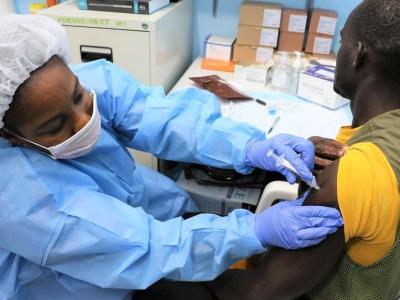USDA awards contracts for stockpiled avian flu vaccine for poultry
The US Department of Agriculture (USDA) has awarded contracts to two companies to manufacture doses of avian flu vaccine for the nation's veterinary stockpile in case the measure is needed to combat the disease in poultry, the USDA's Animal and Plant Health Inspection Service (APHIS) said in a press release yesterday.
"While APHIS has not approved the use of vaccine to respond to HPAI [highly pathogenic avian influenza], the Agency is preparing to ensure that vaccine is available should the decision be made to use it during a future outbreak," the agency said in the release. "Any decision to use vaccination in a future HPAI outbreak would require careful consideration of the efficacy of the vaccine, any impacts of using HPAI vaccine in the field, and the potential trade impacts."
The companies producing the vaccine for the stockpile are Harrisvaccines of Ames, Iowa, and France-based Ceva. Although APHIS did not specify the amount of the awards or the doses requested, Harrisvaccines said in a news release today that it was awarded $6 million, and fulfillment will span more than 2 years. The USDA has requested that the company provide 48 million vaccine doses total, 25 million of them within 45 days.
Ceva's contract is also for $6 million but for 100 doses, according to a press release e-mailed to CIDRAP News and comments from a company spokesperson. All doses are due in 45 days. Production will take place at the company's facilities in Lenexa, Kan.
APHIS said in its release that doses must be able to be stored for 5 years and be delivered anywhere in the country within 10 days. Vaccine makers must also test the doses regularly to ensure potency and report the results to APHIS.
Oct 13 USDA press release
Oct 14 Harrisvaccines news release
Vietnam reports 2 new H5N6 avian flu outbreaks
Vietnamese officials yesterday announced two new H5N6 avian flu outbreaks in poultry affecting more than 2,300 birds, according to separate reports posted by the World Organization for Animal Health (OIE).
The larger outbreak affected a backyard flock of 2,000 poultry in Thai Binh province and began on Oct 8. After 100 birds died from the disease, the remainder of the flock was euthanized to prevent disease spread.
One hundred birds also died from H5N6 in a backyard flock in Tuyen Quang province in an outbreak that began on Oct 9. The remaining birds were likewise culled. Officials have responded to both outbreaks, which are in northern Vietnam, with typical steps such as disinfecting the premises and increasing local surveillance efforts.
Vietnam has now reported six H5N6 outbreaks in domestic birds since August.
Oct 13 OIE report on Thai Binh outbreak
Oct 13 OIE report on Tuyen Quang outbreak
Study shows doubling of drug-resistant E coli incidence in Southeast
Infections from extended-spectrum beta-lactamase (ESBL)–producing Escherichia coli bacteria—which are highly resistant to antibiotics—have almost doubled in community hospitals, according to a study yesterday in Infection Control & Hospital Epidemiology.
A Duke University team analyzed data from health records at 26 community hospitals in the southeastern United States from 2009 through 2014. The researchers found that the incidence of ESBL-producing E coli increased from 5.28 to 10.5 infections per 100,000 patients during that period. The number of hospitals reporting ESBL-producing E coli infections also increased, from 17 to 20.
The investigators also found that the incidence of these strains has begun to surpass that of other bacteria, such as ESBL-producing Klebsiella pneumoniae. Overall, most ESBL-producing E coli cases occurred after exposure to the healthcare system, with nearly three-quarters either hospital-onset or healthcare-associated. They noted, however, a concerning rise in community-associated infections and that the incidence of hospital-onset cases remained stable over the study period.
"The lack of active screening for ESBL-producing bacteria in the majority of American hospitals means that infection prevention measures, such as contact isolation and patient cohorting, are not applied to patients who do not have symptoms, but who may be colonized with the bacteria," said lead author Joshua Thaden, MD, PhD, in a news release from the Society for Healthcare Epidemiology of America (SHEA). "These 'silently' colonized patients increase the risk of transmission to vulnerable patients via healthcare workers or environmental contamination, compromising safety and quality of care."
Thaden also pointed out that unnoticed infections also mean the actual rate of bacterial acquisition might be much higher than the study suggests.
Oct 13 Infect Control Hosp Epidemiol abstract
Oct 13 SHEA news release













